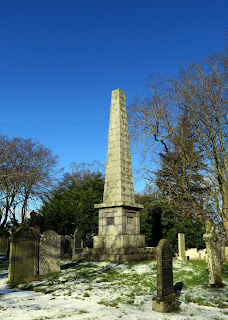The parish of Forglen was created from Marnoch and Alvah in the mid 17th century. The kirkyard and remains of the long abandoned kirk are pleasantly situated above the Devron in the heart of rural Buchan about 2.5 miles west of Turriff. Surrounded by rolling fields of reddish earth Forglen kirk has been described as being in the centre of,
'a parish of fertile soil, well-sheltered and with a mild climate'. Dedicated to St Ternan, the kirk was in use until 1806 and once contained the incomparable Monymusk Reliquary, considered to be one of the great treasures of Scotland. The Reliquary which was carried at the head of the Scots army at Bannockburn, contained relics of St Columba.
 |
| The kirkyard gates, on the left part of the bole of the vast beech tree which dominates the kirkyard, it is tempting to speculate that the tree may be as old as the ruins of the kirk. |
 |
| All that remains of the kirk is a plain rectangle orientated east - west, and deeply littered with beech leaves. On the inside of the east wall directly opposite the doorway is a tablet proclaiming that 'This church was re-edified by George Ogilvie, Master of Bamff, 1652'.The church at Forglen was mentioned in a charter of Arbroath Abbey dated 1204. and it is likely that the building has seen several reincarnations over the centuries. |

 |
Memorial to George Findlater V.C.
15 February 1872 - 4 March 1942
One of eleven children, George Findlater, V.C. was the son of a Turriff miller and left school at the age of 13. He worked as a farm labourer before joining the Gordon Highlanders when he was sixteen. He became a piper and was involved in the Chitral Expedition on the North West frontier of British India, now Pakistan. He was awarded the V.C. for his bravery at Dargai Heights, where on 20th October 1897, despite being shot in both feet and unable to stand, he sat and played his pipes to encourage his comrades to charge. Findlater was discharged from the army and for sometime made a living by playing his pipes in music halls in the U.K. and North America. This was frowned upon by the British Military. He returned to Scotland in 1899 and took up farming in Banffshire. At the outbreak of the Second World War he rejoined the Gordon Highlanders and fought at Loos before again being discharged. He later became a Pipe Major in the Turriff Pipe Band. |

Brigadier General William James St John Harvey of the Black Watch was the eldest son of the Harveys of Carnousie and served with distinction in both the Boer War and 1st World War. He was wounded in an attack on Hanna on the River Tigress on January 20th 1916 and died of his wounds at Amara on 1st February. He was mentioned in dispatches four times between 1914 and his death. He is buried at the Amara Cemetery in Iraq.
 |
| A winged soul on the stone commemorating the splendidly named 'George Herrygery, once miller at Milne of Ribra d.21 December 1735 aged 94. |
 |
| This beautifully carved stone is now set in the kirkyard dyke, note the unorthodox spelling and the mortality symbols, the died bell, skull, book of life and hour glass. |










































